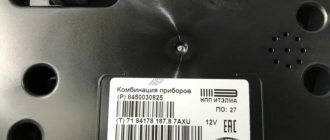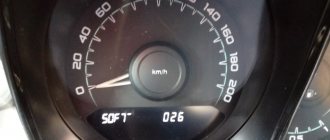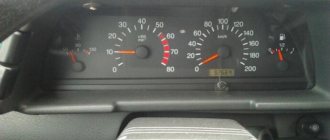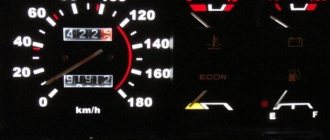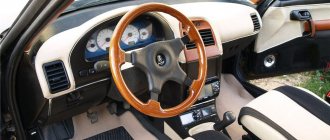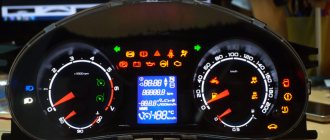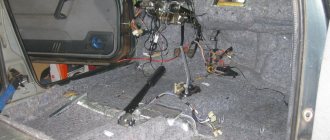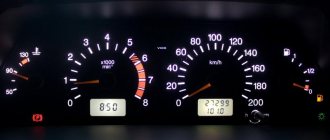Crickets inside the dashboard (instrument panel) sooner or later appear on any car, regardless of the brand or class, and new AvtoVAZ products are no exception. Let's look at the main reasons for the appearance of squeaks, rattles and other extraneous plastic noises in the area of the Vesta panel, as well as ways to combat them.
Eliminating “crickets” in the dashboard of Lada Vesta
A typical factory disease of most AvtoVAZ models - creaking instrument panels or dashboards - did not spare the plant's flagship Lada Vesta. Creaking and rattling in the instrument panel in the area of the steering wheel, most pronounced while the car is moving, is noted by many Vesta owners. Extraneous noise in the cabin is always extremely annoying and gets on the nerves of almost every car enthusiast. During operation, drivers nevertheless experimentally identified the source of extraneous noise - these are the wells of the instrument cluster of the panel, or rather the plastic panel located behind them.
Despite the fact that Vesta’s instrument panel is more modern compared to previous AvtoVAZ dashboards and is structurally different from them, its fastenings turned out to be unfinished. It is in the design of the fasteners, or rather the plastic panel located behind the wells of the instrument cluster, that a cricket appears - an extraneous unpleasant noise. Fixing this problem is not so difficult; you only need to dismantle the instrument panel and solve it using Madeleine or another anti-creaking agent. Madeline is the most popular ultra-thin adhesive-based material among car mechanics and car enthusiasts, which allows you to neutralize the friction process and eliminate the occurrence of any extraneous sounds and is widely used to eliminate all kinds of crickets. To remove the Vesta dashboard you will need a simple screwdriver and a T20 socket. The entire process of dismantling the panel and instrument cluster takes a little time.
It is known that any repair begins with disconnecting the battery terminal. After that, you need to unscrew the 2 screws securing the dashboard indicated in Figure 1 and, holding the top part of the panel (marked with number 2 in the figure), easily pull it towards you until the characteristic clicks of the release of the latches appear.
Then unscrew 2 more self-tapping screws securing the instrument cluster located on its sides (marked with number 1 in Figure 2)
Pull the instrument cluster towards you and disconnect the connector with wires on the reverse side (marked number 3 in Figure 3), and then remove the instrument cluster.
There is a plastic shield right behind the instrument cluster that makes knocking and squeaking noises. To eliminate them, you need to cover the shield itself and all places where it comes into contact with the elements of the dashboard. These problem areas are indicated in more detail in the figures below:
After finishing the work on the anti-squeak sticker, the dashboard should be installed in the reverse order. That is, connect the electrical connector of the panel and secure it with the screws, after which you need to test the functionality of all panel indicators and only after making sure that they are working properly, secure the cover. To check the indication, you need to start the process of automatic diagnostics of the instrument panel, which the AvtoVAZ developers equipped Vesta with.
To check, you need to turn off the ignition switch, then press and hold the “up” button indicated in the figure on the on-board computer control knob located on the steering wheel.
Then turn on the ignition switch and carefully observe the instrument panel display. All instrument needles should move fully, and all lights and indicators should light or flash. If this does not happen, or not all indications are lit or flashing, then you should double-check the reliability and integrity of the connection of the dashboard wiring connector. If after checking the fault does not resolve, contact an authorized service station.
Knocks in the rear suspension
Judging by the reviews of car owners, Renault left Vesta a legacy of fairly rapid wear and tear of the silent blocks of the rear beam. They begin to bother you already at the third ten thousand kilometers. Another reason for knocking noises can be the destruction of the shock absorber support.
Diagnostics
Diagnosing a problem with a car's rear suspension is not easy, despite its simple design. The difficulty lies in the massiveness of the parts, so full diagnostics can only be carried out on a special lift.
Repair
To the delight of car enthusiasts, the rear suspension of the Lada Vesta has one advantage: it is easy to repair. You can even replace shock absorber mounts at home. But changing the silent blocks of a beam without a lift is very difficult. It is advisable to contact a car service center with such a problem.
The article does not reveal a step-by-step repair algorithm, but it answers the question of how you can diagnose the malfunction yourself. If you know the list of works, then the likelihood that the car service center will try to impose unnecessary work is reduced to zero, and this is a direct cost savings.
Lada Vesta dashboard creaking - what to do?
Creaks and crickets in the interior of a new car always upset and irritate the owner. Of course, as they say, this does not affect the speed, but it is unlikely that anyone will agree to endure this for a long time. The same problem exists with the new sedan from AvtoVAZ - many owners note the creaking of the Lada Vesta dashboard, and it can also appear on completely new cars.
Lada Vesta ergonomic shortcomings
Over the course of two months of driving the new Lada Vesta, several major ergonomic shortcomings were identified. The first drawback is the design of the knob for the Lada Vesta multimedia system. The fact is that this knob is very similar to the one found in the Lada Granta model. It is quite slippery and small, making it quite difficult to use with your fingers. The second ergonomic flaw is the adjustable key to the ignition switch. The fact is that when it is inserted into the ignition switch, it interferes with the driver’s right knee in those moments when the leg is resting, having taken off the gas pedal. The third drawback is related to snow getting into the Lada Vesta interior when opening the doors.
What to do?
To independently eliminate the creaking of the Lada Vesta dashboard, you first need to remove it. To do this, first remove the negative terminal from the battery. Next, using a screwdriver and a T20 bit, you need to unscrew the 2 mounting screws. When this is done, you need to pull the dashboard panel towards you, and you will feel the resistance of the clamps.
When the wells are removed, you will have access to the remaining 2 screws that secure the dashboard itself. They also twist out.
In the end, all that remains is to remove the shield and disconnect the plug going to it.
As for the creaking of the Lada Vesta dashboard, it does not come from the dashboard itself, but from the plastic ebbs on which it rests.
To eliminate it, you need to clean the plastic from dust, wipe it with anti-silicone and then cover everything with madeline - both the shield itself, its seat under the visor, and, just in case, the wells.
The entire work process is shown in the video.
Assembly is carried out in reverse order.
Source
Loose wheel bolts
The situation when the fastening bolts of one or several wheels have become loose is typical not only for Lada Vesta, but occurs frequently. There can be many reasons - from inattention during tire fitting to an unsuccessful attempt to steal a wheel.
If a knocking sound occurs while driving, the first step is to perform the most accessible action - stop the car and check the tightness of the wheel bolts, since a tire that falls off while turning can cause the car to roll over with unpredictable consequences. In this case, diagnostics is inseparable from troubleshooting.
After tightening the bolts or making sure that the reason for the knocking is not their tightening, you can continue driving. If the problem is not solved, you should not put off diagnosis for a long time. In order not to aggravate the situation when one malfunction causes another, it is strongly recommended to contact an authorized dealer as soon as possible for qualified diagnosis and elimination of the causes of knocking or other abnormal suspension noises performed on a car raised by a lift.
How to eliminate squeaks in the Lada Vesta instrument cluster
AVTOVAZ equipped Vesta with a modern instrument panel, which differs significantly from the panels of previous Lada models. But the design of the fastenings turned out to be not very successful, which is why a cricket may appear behind the Vesta dashboard (extraneous sound in the form of creaking, knocking or rattling). You can get rid of it with a simple modification.
The source of the chatter is the plastic shield, which is located behind the instrument cluster. To eliminate it, it is necessary to glue with anti-squeak all the contact points of this plastic element, as well as parts of the instrument panel itself. No glue will be needed if the material has a self-adhesive backing.
The process of eliminating squeaks is also shown in the video:
After that, connect the panel and secure it with screws. Before installing the cover, make sure by testing that all indicators and devices are working properly. After this modification, you will forget for a long time about extraneous noise from the Vesta dashboard. Let us remind you that if you decide to install additional sound insulation, we recommend starting with the doors.
Knocks, crunching in the rear suspension
In the rear suspension, knocking is eliminated according to AvtoVAZ's instructions. It is necessary to remove the rear shock absorber strut and place a washer under the upper support (No. 5).
It is worth noting that after such modification, a gap appears between the support and the body, into which dirt can get in. To eliminate this, it is recommended to install a gasket according to the following dimensions:
Other sources of extraneous noise from the rear:
_x000D_
- _x000D_
- handbrake cable (fasten to ties); _x000D_
- trunk lid dampers (lubricate with silicone grease, loosen); _x000D_
- trunk lock (lubricate the lock, eliminate play); _x000D_
- in the area of the rear support, pull the bump stop down along the strut rod (pull it out of the support sleeve), spray silicone spray into the support sleeve and put the bump stop in place. _x000D_
- rear seat back locks (lubricate, apply electrical tape). _x000D_
- things or tools in the trunk. _x000D_
_x000D_
How to diagnose the Vesta suspension yourself. If the rear knock only appears when braking, then this is a different case.
Left side of the dashboard
Many owners notice squeaks coming from the steering wheel while driving. It turned out that unpleasant sounds are produced by the wells of the Vesta instrument cluster.
Another source was found in the area of the windshield pillar trim (the point of contact between the trim and the dashboard). To remove this trim you must first remove the seal. Then pull the trim away from the door, snapping off the plastic pistons, then pull it up, removing the hooks at the bottom of the trim from the panel. We glue anti-squeak (madeleine) on the rubbing areas. If necessary, replace the plastic clips with new ones. We similarly modify the design on the right side.
Other possible sources of extraneous noise:
- An air duct that is directed to the driver’s feet;
- Mounting block (located near the driver’s left foot) and many wires behind it;
- Plastic steering column cover;
- Upper air duct (how to remove).
In these cases, we eliminate the problem of squeaks and rattles according to the situation, using vibration material and madeleine.
Wear of stabilizer bushings
If, when driving over a speed bump, a dull knock or squeak is heard from the front, there is a high probability that the reason for this is premature wear, due to the poor quality of the material, of the standard anti-roll bar bushings of the Lada Vesta - a malfunction typical of the VAZ sedan. In this case, other signs corresponding to the assumption should be present:
- knocking of the chassis when the car rolls while moving;
- beating in the steering wheel when driving on a flat surface at speeds above 60 km/h;
- increased play in the steering mechanism during intensive maneuvering;
- involuntary deviation of the car from straight-line movement.
The final conclusion will be made by inspecting the car on a car lift - if the bushings are swollen, have lost their geometry and elasticity, then they need to be replaced.
Replacing anti-roll bar bushings
If the dealer service center is remote and standard spare parts are available (catalog number: 8450006748), you can do this work yourself, with minimal risk of subsequent detection of independent intervention. After the warranty period has expired, or at the dealer, it is better to replace these parts with higher quality analogues, for example, polyurethane bushings from Lada Chevrolet Niva (article No. 17012680) or products from other manufacturers according to the dimensions indicated in the pictures.
To do the job you will need the following tool:
- TORX 40 angle wrench;
- ring wrenches “13” and “16”;
- 10" head with extension and wrench.
Work order:
- Using a 10mm socket with an extension, remove the protective cover of the steering mechanism;
- Using a 13mm spanner, remove the two rear bolts securing the steel brackets of the bushings;
- Using a T40 wrench, unscrew the front bolt securing one of the two brackets and remove the bracket;
- remove the old bushing from the stabilizer, clean and lubricate the hole in it with silicone grease, install a new bushing through the cut on it and first fix the steel bracket with the front bolt;
- replace the second bushing in the same way;
- tighten the 4 bracket fastening bolts with a force of 2.0-2.4 kgf m;
- Install the steering gear protective cover.
Central part of the panel (console)
According to owner reviews, squeaks on Vesta can come from the central air ducts in the radio area. We remove them and the central frame of the console itself, and then glue it with anti-squeak, as shown in the photo:
Cricket from the deflector control knobs is eliminated like this (glue madeline), author:
Addition from PDA user:
Unconnected blocks with wires located inside the panel (dashboard) can also rattle.
Don't forget about the floor tunnel and the places where it comes into contact with the panel, as well as the control unit for the air conditioner and stove. We cover the rubbing areas with anti-squeak. In places where it is not possible to stick the material, you can apply silicone grease.
Various plastic parts
There is already such a diversity of companies and manufacturing countries that it makes no sense to single out anyone separately, so we’ll just list them.
The air filter and its housing turned out to be from the famous German brand Mann+Hummel, and of original production. The electric fuel pump module assembly (with an Arsan pump) is Russian. The radiator expansion tank hose is from Teklas, but not from Turkey, but from Bulgaria. Washer reservoir with Renault logos, Continental washer pump, made in the Czech Republic.
With the exception of the aforementioned Czech microclimate control unit, the plastic interior parts turned out to be Russian, in particular Izhevsk. Moreover, the quality of fastening (hence the country of production) of individual small parts could be determined by touch - they were either loose or fell out at the slightest touch.
There was also a Russian approach: the plastic frame of the gear lever (Italian-Russian company AE2) that was not “shrunken” was sharpened on the inside (apparently with a file) along the edge. The side plug of the front panel (on the side of the front right door) bounced off like a spring at the first attempt to snap it off (what voltage was it installed under?).
Taking into account some other flaws in the interior assembly in the form of naked screws and gaps, it is worth saying that the interior of the Lada Vesta is generally better assembled than can be expected from most modern Ladas, but it is felt that over time, part of it will traditionally “come to life”. By the way, at first glance we liked the interior assembly of the almost entirely imported Lada XRAY more.
Right side of the dashboard
Most often, squeaks and rattles occur on this side. Crickets appear due to loose fastenings of the air ducts, which are directed towards the feet of the front passenger, unreliable fixation of the body electronics control unit, the glove box cooling air duct, the glove compartment end switch or its fastenings. We looked at how to deal with each ailment separately earlier.
By analogy with the left side, we modify the plastic trim of the windshield pillar and the upper air duct.
It is worth noting that extraneous noise can be reflected in the Vesta’s cabin, so sometimes it is very difficult to determine the source. It seems that the squeaks are coming from the side of the panel, but in fact it is the door trim (see sound insulation) or the lock that just needs to be lubricated.
Have you encountered squeaks and rattles in the Vesta cabin? How did you get rid of these crickets? Leave your recommendations and participate in the survey, this will allow other car enthusiasts to quickly find the source of the problem.
To watch online, click on the video ⤵
LET'S REMOVE CRICKETS OUT OF THE WEST ONCE AND FOR ALL! NOISE AND CREAKING GOODBYE! More details
Lada Vesta LADA Vesta squeaks, crickets in the cabin! More details
THE WIFE BREAKS THE NEWS! CRICKET IN THE DOOR Read more
VESTA CROSS 2022. Tired of squeaking! Let's disassemble the instrument panel and glue it! More details
LADA VESTA PERFECT SILENCE Read more
Vesta Cross 2022. Removing creaking Multimedia frames. More details
We eliminate squeaks in the Lada Vesta interior Read more
How easy it is to find crickets in the interior of a car! More details
HOW TO ELIMINATE creaking / REMOVE CRICKLES AND PLASTIC NOISE IN THE CAR INTERIOR / SILICONE LUBRICANT / WAX More
Forget about the creaking of the panel by installing THIS on Granta! More details
Anti-creak for car. How to eliminate squeaks and crickets in a car Read more
Lada Vesta. We eliminate the well-known extraneous noise in Read more
It's better than SOUND INSULATION!! More details
We are finishing the marigolds on West Read more
Cricket in the cabin until the car warms up. Lada Vesta creaking, rattling in the dashboard Read more
How to eliminate crickets and creaking plastic in the cabin? More details
Removing the dashboard. Eliminating squeaking Lada Vesta Read more
Lada Vesta We get rid of knocks and clicks when the tunnel moves laterally. More details
Elimination of factory defects. LADA Vesta instrument panel console creaking More details
Left side of the dashboard
Many owners notice squeaks coming from the steering wheel while driving. It turned out that unpleasant sounds are produced by the wells of the Vesta instrument cluster.
Another source was found in the area of the windshield pillar trim (the point of contact between the trim and the dashboard). To remove this trim you must first remove the seal. Then pull the trim away from the door, snapping off the plastic pistons, then pull it up, removing the hooks at the bottom of the trim from the panel. We glue anti-squeak (madeleine) on the rubbing areas. If necessary, replace the plastic clips with new ones. We similarly modify the design on the right side.
Other possible sources of extraneous noise:
- An air duct that is directed to the driver’s feet;
- Mounting block (located near the driver’s left foot) and many wires behind it;
- Plastic steering column cover;
- Upper air duct (how to remove).
In these cases, we eliminate the problem of squeaks and rattles according to the situation, using vibration material and madeleine.
Transmission noise
A noise is heard from the gearbox, a small knock that disappears when you press the clutch pedal.
There are 2 misconceptions:
- The release bearing hummed. But it shows itself only at the moment the pedal is pressed, when the load on the clutch bearings begins.
- The input shaft bearing is humming. This is also incorrect, since SKF bearings have been installed on VAZ boxes for many years. There is practically no marriage on them.
In fact, the culprit of the knock is the clutch driven disc, namely its central bushing.
It has play in the seat. During torsional vibrations at idle, a fractional knock appears. The problem is solved by installing new clutch discs.
Central part of the panel (console)
According to owner reviews, squeaks on Vesta can come from the central air ducts in the radio area. We remove them and the central frame of the console itself, and then glue it with anti-squeak, as shown in the photo:
Cricket from the deflector control knobs is eliminated like this (glue madeline), author:
Addition from PDA user:
Unconnected blocks with wires located inside the panel (dashboard) can also rattle.
Don't forget about the floor tunnel and the places where it comes into contact with the panel, as well as the control unit for the air conditioner and stove. We cover the rubbing areas with anti-squeak. In places where it is not possible to stick the material, you can apply silicone grease.
What's the outcome
The findings are mixed. The main one is that in terms of quality and level of assembly, Lada Vesta is probably the best car among the products of our automobile industry, at least in modern history. However, a large number of annoying and minor “jambs” do not yet allow our sedan to catch up with Western competitors, and at a comparable price.
The second conclusion is that calling Vesta domestic, having broken it down into spare parts, is hard to come by. Especially if you remember that even those branded components that are produced in Russia are made on imported machines, using imported raw materials.
Well, the third conclusion: you can forget about any Vesta service outside of professional service. At the dacha you can only change the brake pads and pump up the tires yourself. Apparently, this is also why car sales in the regions turned out to be worse than expected. In general, we will now keep an eye on our ward and be sure to inform you about all the joys and hardships.
Right side of the dashboard
Most often, squeaks and rattles occur on this side. Crickets appear due to loose fastenings of the air ducts, which are directed towards the feet of the front passenger, unreliable fixation of the body electronics control unit, the glove box cooling air duct, the glove compartment end switch or its fastenings. We looked at how to deal with each ailment separately earlier.
By analogy with the left side, we modify the plastic trim of the windshield pillar and the upper air duct.
It is worth noting that extraneous noise can be reflected in the Vesta’s cabin, so sometimes it is very difficult to determine the source. It seems that the squeaks are coming from the side of the panel, but in fact it is the door trim (see sound insulation) or the lock that just needs to be lubricated.
Have you encountered squeaks and rattles in the Vesta cabin? How did you get rid of these crickets? Leave your recommendations and participate in the survey, this will allow other car enthusiasts to quickly find the source of the problem.
Source
Fuse box and its housing: Renault brand, made in Romania
The fuse box comes entirely from the Logan model, as evidenced by the Renault logos on the body and the Romanian manufacturer Capirom. True, AvtoVAZ reported that in the near future the company will change its supplier to a local one - from the Samara region.
We didn’t have any questions regarding the unit itself, but during a scrupulous study by the electricians, a very interesting point emerged
Attention was drawn to two fuses that were not indicated either on the diagram or in the instructions. A study of the electrical circuit revealed that during a sudden voltage surge (for example, when lighting a Vesta with the engine running), these fuses may burn out, which will stop charging the battery
And what’s most insidious is that the driver of a discharged car will not know about it - no electrical “paths” to the dashboard (indicator lamps) could be found. Whether the reason will be revealed when connecting the standard diagnostic system in the absence of an error that pops up is also a question.
Lack of arrow indicators
Often, the reason for the lack of indications of arrow indicators is the corresponding sensors. Let's look at each device separately:
- Tachometer. The cause of failure of the tachometer can only be the device itself, since failure of the crankshaft position sensor or ECU will result in a complete stop of the engine.
- Speedometer. If the cause of the breakdown is not the device itself, then along with the lack of speed readings you will also see a burning ABS lamp (malfunction of the speed sensors).
- Coolant temperature gauge. The ECU transmits information from the temperature sensor, a malfunction of which can lead to a lack of readings.
- Fuel level indicator. The reason for the lack of readings from this device may be a malfunction of the fuel module.
Remove the instrument panel of the Lada Vesta only after diagnosing all the sensors associated with the pointer indicators.
Posts 1 to 25 of 63
1 Topic from Pluto 2016-03-30 07:25:38 (2018-03-22 02:46:55 edited by Pluto)
- Pluto
- Participant
- Inactive
- Posts: 60
- Thank you: 29
Subject: Knocking noise from front left
Has anyone encountered this problem, please tell me what it could be. When driving through potholes with sharp edges, a dull clanging sound is heard from below on the left, reminiscent of the knock of an unscrewed disk on the hub. The sound is best noticeable at low speed when driving in 1st or 2nd gear. Then it just gets muted. The defect occurred immediately after purchase. A visit to the dealer revealed nothing.
Currently, AVTOVAZ produces standard polyurethane bushings for Vesta. The stabilizer does not creak in them.
Outdated information: (I decided to collect information (from the Internet) on stabilizer bushings and struts that fit us. Correct, add, I’ll post it here.
Struts: Renault 54 61 800 02R (274 mm) or 8200 669 065 (283 mm) lemforder 3710901 Bushings: Chevrolet Niva (2123-2906046R?) (small) install without cutting with soap>
- Petty
- Participant
- Inactive
- Posts: 966
- Thank you: 271
Re: Knocking noise from front left
3 Reply from d.PO 2016-03-30 14:07:10
- d.P.O.
- Participant
- Inactive
- Posts: 149
- Thank you: 24
Re: Knocking noise from front left
But did they listen to the knock? what and how did you check? Did you do any broaching at all?
4 Reply from Pluto 2016-03-30 22:27:54
- Pluto
- Participant
- Inactive
- Posts: 60
- Thank you: 29
Re: Knocking noise from front left
We stretched out the subframe and everything we could reach from below. We shook the ball joint and hub, and the stub drains. They also seem to have rocked the steering tips. They spread their hands. Today I looked down and there are a lot of nuts and bolts on the subframe. I would have to stretch them all out. The most interesting thing is that when you rock the car in a parking lot, nothing rattles, but on sharp potholes, yes. Maybe the shock absorber is defective, but how can you tell?
5 Reply from Pluto 2016-03-31 22:08:55
- Pluto
- Participant
- Inactive
- Posts: 60
- Thank you: 29
Re: Knocking noise from front left
Today I remembered all the problems again and went to the dealer. The source of the sound has been identified. This is the knocking of the anti-roll bar. His lateral movement limiter is faulty, as I understand it. The defect was recognized as covered by warranty. They will change the stabilizer as soon as a new one arrives. Will wait.
6 Reply from Axel 2016-04-02 08:30:11
- Axel
- Participant
- Inactive
- Posts: 973
- Thank you: 139
Re: Knocking noise from front left
It won't last long. We need to install something else, better quality.
7 Reply from Pluto 2016-04-02 13:28:42 (2016-04-02 13:31:24 edited by Pluto)
- Pluto
- Participant
- Inactive
- Posts: 60
- Thank you: 29
Re: Knocking noise from front left
What, have you already had experience replacing the stabilizer?
8 Reply from Dimidrol 2016-04-03 01:31:28 (2016-04-03 02:04:44 edited by Dimidrol)
- Dimidrol
- Participant
- Inactive
- Posts: 11
- Thanks: 4
Re: Knocking noise from front left
Looks like I have the same problem. I went to the officials, but of course they didn’t find anything. What does this limiter even look like, how was it diagnosed?
9 Reply from Axel 2016-04-03 07:04:40
- Axel
- Participant
- Inactive
- Posts: 973
- Thank you: 139
Re: Knocking noise from front left
So they exchange it for the same one. That means the new one will knock too.
- Pluto
- Participant
- Inactive
- Posts: 60
- Thank you: 29
Re: Knocking noise from front left
I didn’t catch up with the diagnostic process, so I gave the car away for half a day through a personal manager. They found it themselves. I rummaged through the technological instructions (https://yadi.sk/d/zTESYkz0mDbKY; https://yadi.sk/i/jd13nycwoyZVi links from the documentation section) and, as I understood from the explanations, the “belt on the stabilizer bar” fig. 7-2. You can look at it using a mirror. To be honest, I haven’t looked at it myself, but I’ll look in soon. It's a very uncomfortable place - behind the steering rack. By the way, such a knock could have occurred on the right side if the belt had broken on the other side. Honestly, this defect ruined the whole impression of the car.
